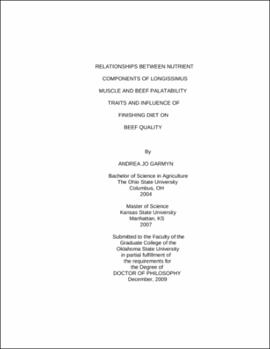| dc.contributor.advisor | Hilton, Gretchen | |
| dc.contributor.author | Garmyn, Andrea Jo | |
| dc.date.accessioned | 2013-11-26T08:22:34Z | |
| dc.date.available | 2013-11-26T08:22:34Z | |
| dc.date.issued | 2009-12 | |
| dc.identifier.uri | https://hdl.handle.net/11244/6597 | |
| dc.description.abstract | Scope and Method of Study: The first objective was to determine the influence of beef longissimus nutrient components on beef palatability traits by utilizing cattle from two related herds. Longissimus muscle (LM) samples were obtained and fabricated into steaks for trained sensory panel, Warner-Bratzler Shear force (WBS), thiobarbituric acid reactive substances (TBARS), and healthfulness (fatty acid and mineral composition) analysis. The goal of the second study was to assess the influence of finishing diet on carcass traits, beef palatability, and color stability of LM of Angus heifers. Steaks were fabricated similarly to the correlation study with the addition of a steak for simulated retail display. | |
| dc.description.abstract | Findings and Conclusions: Specific mineral concentrations did not demonstrate strong correlations with WBS, sensory traits, or TBARS, and significant correlations were not consistent between the two cattle populations. Linoleic acid (C18:2) was the only fatty acid significantly correlated (P < 0.05) with WBS in California samples, but C18:1, C18:2, C18:3n-3, C18:3n-6, and MUFA were significantly correlated with WBS in Iowa samples. There were weak correlations (P < 0.05) with C16:0, C18:0, C18:1, C18:2, SFA, and MUFA in Iowa samples for initial and sustained juiciness. Specific fatty acids that demonstrated significant correlations with sensory tenderness ratings were generally weak and inconsistent between the two populations. Beef flavor was positively correlated (P < 0.05) with C14:0, C16:0, C18:1, and MUFA in both populations. Painty/fishy flavor was negatively correlated (P < 0.05) with C18:2 and PUFA in California samples, but was positively correlated (P < 0.05) with the same traits in Iowa samples. There were no consistent relationships between lipid composition and livery/metallic flavor between the two populations. | |
| dc.description.abstract | Carcasses from grain-fed heifers were fatter at the 12th rib and internally and had higher numerical yield grades and marbling scores than forage-finished heifers (P < 0.05). Steaks from grain-fed heifers had lower WBS values, higher tenderness ratings, higher beef and painty/fishy flavor, and lower grassy/cowy flavor than forage-fed beef (P < 0.05). Diet did not affect color, except grain-fed heifers had steaks with higher (P < 0.05) L* values than steaks from forage-fed heifers. | |
| dc.format | application/pdf | |
| dc.language | en_US | |
| dc.rights | Copyright is held by the author who has granted the Oklahoma State University Library the non-exclusive right to share this material in its institutional repository. Contact Digital Library Services at lib-dls@okstate.edu or 405-744-9161 for the permission policy on the use, reproduction or distribution of this material. | |
| dc.title | Relationships between nutrient components of longissimus muscle and beef palatability traits and influence of finishing diet on beef quality | |
| dc.contributor.committeeMember | Morgan, J. Brad | |
| dc.contributor.committeeMember | VanOverbeke, Deborah | |
| dc.contributor.committeeMember | Mateescu, Raluca | |
| dc.contributor.committeeMember | Step, D. L. | |
| osu.filename | Garmyn_okstate_0664D_10648.pdf | |
| osu.accesstype | Open Access | |
| dc.type.genre | Dissertation | |
| dc.type.material | Text | |
| thesis.degree.discipline | Food Science | |
| thesis.degree.grantor | Oklahoma State University | |
